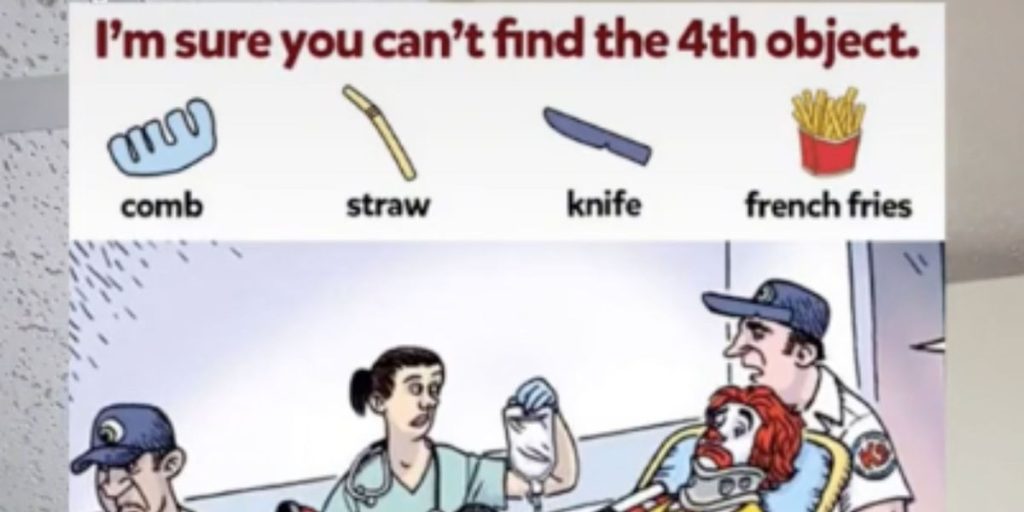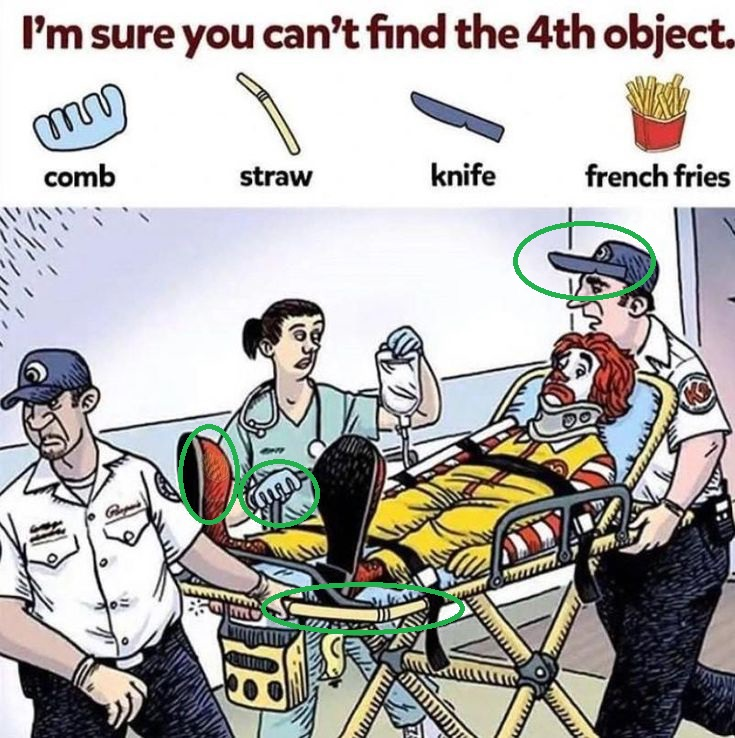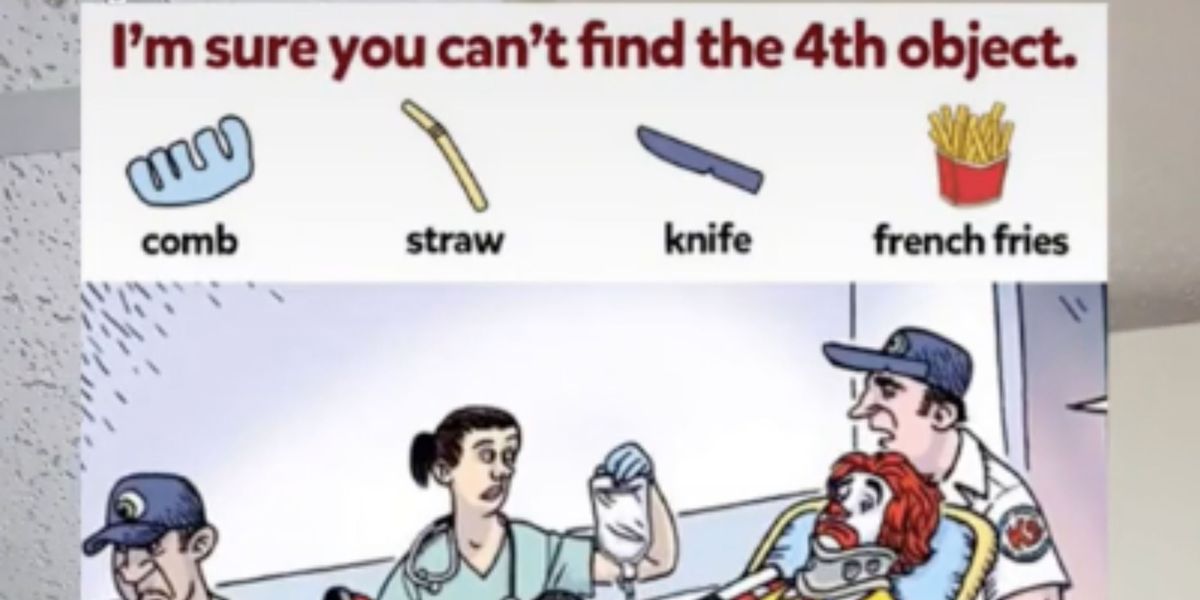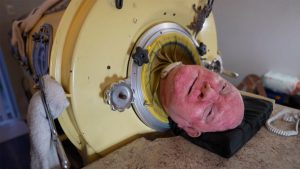
Are you ready for a visual challenge that’s guaranteed to sharpen your brain and test your focus? Hidden object puzzles have become a favorite pastime for people of all ages—and for good reason. They’re not only fun but also offer excellent cognitive benefits, including improved memory, attention to detail, and problem-solving skills.
In this particular puzzle, you’re invited to take part in a fun visual hunt. Somewhere in this busy image are four well-hidden everyday objects: a comb, a straw, a knife, and a pack of French fries. At first glance, the image might look like a collection of random shapes and colors. But with a bit of patience and a sharp eye, you’ll start to notice some clever camouflage and surprises.
Why Are Hidden Object Puzzles So Popular?
Hidden object games and puzzles have surged in popularity, not only among children but also among adults. According to research published in the Journal of Cognitive Enhancement, brain-training tasks like puzzles can support mental agility, especially in older adults (source: Springer Nature). Whether it’s a “find the object” picture or a more complex brain teaser, engaging in these activities activates key areas of the brain involved in spatial awareness, memory, and attention.
Plus, there’s the added benefit of reducing stress. A study from Frontiers in Psychology noted that when people focus deeply on visual puzzles, it creates a “flow state” similar to meditation, where the brain temporarily forgets worries and focuses solely on the task at hand.
So while this might just feel like a fun challenge, you’re also giving your brain a workout!

The Challenge: Spot the Hidden Items
Let’s dive into the challenge. The goal is simple:
🔍 Find the following four items in the image:
- Comb
- Straw
- Knife
- French Fries
These objects are cleverly disguised in the image. Some may be tucked behind other items, while others may be hidden in plain sight, blending into the background with similar colors and shapes.
Think you can spot them all in under 30 seconds? That’s the ultimate goal!
Pro Tip: Don’t rush. Take a moment to scan each section of the image. Focus on the edges, corners, and any unusual patterns. Sometimes the objects are designed to mimic parts of other items.

Why 30 Seconds?
The 30-second timer isn’t just a fun challenge—it’s based on studies that suggest our attention spans have become shorter in the digital age. A study from the Journal of Behavioral Addictions found that frequent use of digital technology can reduce attention spans, making short, focused tasks an ideal way to retrain the brain to focus better.
Challenging yourself with a time limit also boosts adrenaline and makes the game feel more exciting. It’s a harmless way to introduce a bit of competition, even if it’s just against the clock—or your friends and family!
Struggling to Spot All Four?
No worries! These puzzles are meant to be tricky. If you’re having trouble finding all the items, you’re not alone. Many people miss one or two items on their first try. It’s all part of the fun.
Here’s a little mental strategy:
- Scan Methodically: Start in one corner of the image and work your way across.
- Use Shape Recognition: Focus on the outlines of the objects you’re searching for. What shape does a comb typically have? A knife? Let that guide your eyes.
- Zoom in (if possible): On digital versions of the puzzle, zooming in may help you notice finer details.
The Answer (Spoiler Alert!)
Still can’t spot them all? That’s perfectly okay! Sometimes our brains just don’t catch certain patterns or blends. Ready to find out where everything is?
🧠 Here’s where the hidden objects are usually found in these types of puzzles:
- Comb: Often hidden as part of someone’s hair or as a texture in the background.
- Straw: Might look like part of a striped pattern or blend into a drink illustration.
- Knife: Frequently placed along a border or colored to match another long object.
- French Fries: These can be disguised as wooden sticks, yellow lines, or parts of food illustrations.
These tricks are classic in visual puzzle design, which aims to challenge our pattern recognition. Designers use color blending, rotation, and partial obscuring to confuse the brain just enough to delay instant recognition.
Make It a Group Game!
Want to take the fun to the next level? Turn this visual challenge into a group game with your friends, family, or coworkers. See who can find all four items the fastest. You’ll be surprised how competitive it can get!
Ideas for group play:
- Set a 30-second timer and reveal the image at the same time for everyone.
- Keep track of how long each person takes.
- Add more objects in future rounds for an advanced version.
Games like this are also fantastic icebreakers in classrooms, corporate meetings, or virtual team-building events. They require no setup, minimal explanation, and can be completed in just a couple of minutes.

Conclusion: A Simple Puzzle, A Big Brain Boost
What may seem like a lighthearted challenge actually packs a powerful punch in terms of brain benefits. From enhancing visual perception and memory to reducing stress, puzzles like these do more than entertain—they educate and elevate your cognitive performance.
Next time you come across a puzzle asking you to “find the comb” or “spot the hidden knife,” you’ll know that it’s more than just a game—it’s a tool for sharpening your mind.
So whether you solved it in 10 seconds or had to peek at the answers, remember: every time you play, you’re training your brain and having fun doing it.
Sources:
- Springer Nature – Cognitive Training Effects in Older Adults:
https://link.springer.com/article/10.1007/s41465-020-00178-8 - Frontiers in Psychology – Flow State and Mindfulness Through Puzzle Play:
https://www.frontiersin.org/articles/10.3389/fpsyg.2019.00606/full - Journal of Behavioral Addictions – Technology Use and Attention Span Decline:
https://akjournals.com/view/journals/2006/8/1/article-p15.xml


